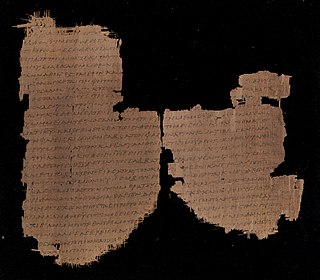Related Research Articles

The Gospel of Luke is the third of the New Testament's four canonical Gospels. It tells of the origins, birth, ministry, death, resurrection, and ascension of Jesus. Together with the Acts of the Apostles, it makes up a two-volume work which scholars call Luke–Acts, accounting for 27.5% of the New Testament. The combined work divides the history of first-century Christianity into three stages, with the gospel making up the first two of these – the life of Jesus the messiah (Christ) from his birth to the beginning of his mission in the meeting with John the Baptist, followed by his ministry with events such as the Sermon on the Plain and its Beatitudes, and his Passion, death, and resurrection.

The Sermon on the Mount is a collection of sayings spoken by Jesus of Nazareth found in the Gospel of Matthew that emphasizes his moral teachings. It is the first of five discourses in the Gospel and has been one of the most widely quoted sections of the Gospels.
Helmut Heinrich Koester was an American scholar who specialized in the New Testament and early Christianity at Harvard Divinity School. His research was primarily in the areas of New Testament interpretation, history of early Christianity, and archaeology of the early Christian period.
Robert Horton Gundry is an American scholar and retired professor of New Testament studies and Koine Greek.
Harold William Attridge is an American New Testament scholar and historian of Christianity best known for his work in New Testament exegesis, especially the Epistle to the Hebrews, the study of Hellenistic Judaism, and the history of early Christianity. He is a Sterling Professor of Divinity at Yale University, where he served as Dean of the Divinity School from 2002 to 2012.

Martin Hengel was a German historian of religion, focusing on the "Second Temple Period" or "Hellenistic Period" of early Judaism and Christianity.

James McConkey Robinson was an American scholar who retired as Professor Emeritus of Religion at Claremont Graduate University, Claremont, California, specializing in New Testament Studies and Nag Hammadi Studies. He was a member of the Jesus Seminar and arguably the most prominent Q and Nag Hammadi library scholar of the twentieth century. He was also a major contributor to The International Q Project, acting as an editor for most of their publications. Particularly, he laid the groundwork for John S. Kloppenborg's foundational work into the compositional history of Q, by arguing its genre as an ancient wisdom collection. He also was the permanent secretary of UNESCO's International Committee for the Nag Hammadi codices. He is known for his work on the Medinet Madi library, a collection of Coptic Manichaean manuscripts.

Roy Alvin Harrisville II was an American Lutheran theologian who wrote extensively on the interpretation of the New Testament.
Luke Timothy Johnson is an American Catholic New Testament scholar and historian of early Christianity. He is the Robert W. Woodruff Professor of New Testament and Christian Origins at Candler School of Theology and a Senior Fellow at the Center for the Study of Law and Religion at Emory University.
John S. (Seargeant) Kloppenborg is a Canadian professor of religious studies with expertise in Greco-Roman culture, Judean culture and Christian origins, particularly the synoptic gospels and Q-source. Kloppenborg is at the University of Toronto since 2007, where he holds the title of university professor. He was elected a member of the Studiorum Novi Testamenti Societas in 1990, and was elected as a Fellow of the Royal Society of Canada in 2014. In 2019-2020 he served as the president of the Studiorum Novi Testamenti Societas. He is also a member of the Context Group, the Society of Biblical Literature, and the Canadian Society of Biblical Studies. He was awarded honorary doctorates from the University of Lethbridge (2011) and the University of Pretoria (2018)
The Gospel of Luke and the Acts of the Apostles make up a two-volume work which scholars call Luke–Acts. The author is not named in either volume. According to a Church tradition, first attested by Irenaeus, he was the Luke named as a companion of Paul in three of the Pauline letters, but many modern scholars have expressed doubt that the author of Luke-Acts was the physician Luke, and critical opinion on the subject was assessed to be roughly evenly divided near the end of the 20th century. The eclipse of the traditional attribution to Luke the companion of Paul has meant that an early date for the gospel is now rarely put forward. Most scholars date the composition of the combined work to around 80–90 AD, although some others suggest 90–110, and there is textual evidence that Luke–Acts was still being substantially revised well into the 2nd century.
Loren T. Stuckenbruck is a historian of early Christianity and Second Temple Judaism, currently professor of New Testament at the University of Munich, in Germany. His work has exerted a significant impact on the field.
Craig S. Keener is an American Wesleyan theologian, Biblical scholar and professor of New Testament at Asbury Theological Seminary.

The Q source (also called The Sayings Gospel, Q Gospel, Q document(s), or Q; from German: Quelle, meaning "source") is an alleged written collection of primarily Jesus' sayings (λόγια, logia). Q is part of the common material found in the Gospels of Matthew and Luke but not in the Gospel of Mark. According to this hypothesis, this material was drawn from the early Church's oral gospel traditions.
Ulrich Luz was a Swiss theologian and professor emeritus at the University of Bern.

The Hebrew Gospel hypothesis is that a lost gospel, written in Hebrew or Aramaic, predated the four canonical gospels. In the 18th and early 19th century several scholars suggested that a Hebrew proto-gospel was the main source or one of several sources for the canonical gospels. This theorizing would later give birth to the two source-hypothesis that views Q as a proto-gospel but believes this proto-gospel to have been written in Koine Greek. After the widespread scholarly acceptance of the two-source hypothesis, scholarly interest in the Hebrew gospel hypothesis dwindled. Modern variants of the Hebrew gospel hypothesis survive, but have not found favor with scholars as a whole.
Seyoon Kim is a biblical scholar, associate dean for the Korean Doctor of Ministry program and professor of New Testament at Fuller Theological Seminary.
Adela Yarbro Collins is an American author and academic, who served as the Buckingham Professor of New Testament Criticism and Interpretation at Yale Divinity School. Her research focuses on the New Testament, especially the Gospel of Mark and the Book of Revelation. She has also written on the reception of the Pauline epistles, early Christian apocalypticism, and ancient eschatology.
François Bovon was a Swiss biblical scholar and historian of early Christianity. He was the Frothingham Professor Emeritus of the History of Religion at Harvard Divinity School. Bovon was a graduate of the University of Lausanne and held a doctorate in theology from the University of Basel. From 1967 to 1993, he taught in the Faculty of Theology at the University of Geneva. Bovon was an honorary professor at the University of Geneva and in 1993 he received an honorary doctorate from the Faculty of Theology at Uppsala University, Sweden. He was president of the Swiss Society of Theology from 1973 to 1977 and president of the Studiorum Novi Testamenti Societas in 2000.
Samuel MacLean Gilmour was a Canadian New Testament scholar, professor at Queen's Theological College, Norris Professor of New Testament at Andover Newton Theological School, and President of the Canadian Society of Biblical Studies and of the Canadian Section of the Society of Biblical Literature and Exegesis. S. MacLean Gilmour also was member of the Editorial Committee of the Journal of Biblical Literature and a member of the Studiorum Novi Testamenti Societas.
References
- 1 2 Betz, Hans Dieter. The Sermon on the Mount. A Commentary. Minneapolis: Fortress Press, 1995.
- 1 2 3 4 Betz, Hans Dieter. The Sermon on the Mount: Its Literary Genre and Function. The Journal of Religion. Vol 59, No. 3 (July 1979), pp. 285-297.
- ↑ The two-source hypothesis is a hypothesis postulated by scholars of the synoptic problem who believe that Mark was the first Gospel written, and that Matthew and Luke used both Mark and another source (Q) in writing their gospels. Robert Stein. Studying the Synoptic Gospels: Origin and Interpretation, p. 284.
- 1 2 3 4 5 H.D. Betz. (1990) "The Sermon on the Mount and Q: Some Aspects of the Problem." ed. James E. Goehring. Gospel Origins and Christian Beginnings: In Honor of James M. Robinson.
- ↑ "BURKITT MEDAL FOR BIBLICAL STUDIES 2000". Prizes and medals. British Academy. Archived from the original on 8 November 2014. Retrieved 9 December 2014.